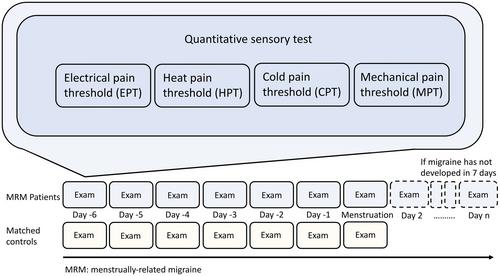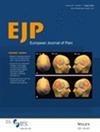Functional neuroimaging studies indicate that central transmission of trigeminal pain may commence up to 48 h prior to the onset of headache. Whether these cyclic changes are associated with somatosensory alteration remains incompletely understood.
The present study aimed to investigate the temporal progression of somatosensory alterations preceding the onset of a migraine attack. Patients with menstrually related migraine (n = 10) and matched healthy controls (n = 13) underwent consecutive daily quantitative sensory tests, commencing 6 days prior to the expected onset of the migraine attack and menstruation. Each subject was investigated for 7–11 consecutive days, resulting in 85 and 91 days of experimentation for the respective cohorts.
Electrical/heat/cold pain thresholds showed a phase-dependent decline towards the spontaneous migraine attack, which had commenced 48 h prior to the onset of the headache. The pain thresholds further declined towards the ictal phase, with only the electrical pain threshold reaching statistical significance (ictal vs. preictal). In healthy controls, the pain thresholds remained stable and unaltered during the consecutive daily measurements. In an exploratory analysis, the pain thresholds at baseline (interictal phase) were comparable between both cohorts.
The data suggest the existence of a trigeminal somatosensory alteration in the preictal phase of migraine, occurring up to 48 h prior to the onset of the headache. This change occurred in a chronologically synchronous manner with the brain activation in the preictal phase in functional neuroimaging studies. It will be important to combine pain threshold measurement and functional neuroimaging in future studies.
Our data suggest the existence of a somatosensory behavioural correlate of the functional neuroimaging changes starting 48 h before the onset of headache. Despite the concurrence of the behavioural and functional neuroimaging changes in a chronological sequence, the next step in elucidating the cause of migraine is to combine the behavioural and functional neuroimaging changes in a temporal sequence, i.e. to identify the generator behind the cyclic sensory fluctuation.



